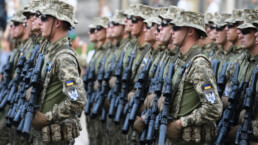The establishment keeps coming up with convenient answers, but always to the wrong question.
By Mark Episkopos, Responsible Statecraft
In her final moments, Getrude Stein is rumored to have asked, “What is the answer?” No reply came from those gathered around her. She followed up with the retort, “but what is the question?”
The maximalist impulse toward Ukraine is approaching its final act in a similarly unenviable state. It, too, is on its deathbed, and it faces what increasingly resembles a crisis of meaning, fueled not by insufficient resources or flagging political will but by an ill-defined theory of victory.
There could never be perfect unanimity in what was a U.S.-led coalition of around 50 nations, but it can be surmised that the initial goal was to enable Ukraine, through a combination of military aid, sanctions, and diplomatic pressure, to decisively degrade and potentially defeat the Russian military. It became clear around the latter half of 2023 — though it must be said that many observers sounded the alarm bells a good while earlier — that some of the presumptions behind this approach were untenable.

Yet, three years in, this approach remains the dominant paradigm for framing the war in the absence of any clearly articulated alternative strategy.
Despite previous experiences with Russian countermeasures against HIMARS and other Western-supplied systems, the belief persists that Ukraine can tilt the balance of forces in its favor if supplied with the right equipment. Last year, it was Leopard tanks and Patriot missile systems. Now, it’s F-16s. Then there is the larger and more important question of the goals for which these weapons should be used.
Recent Posts
Wilson in Seattle and Mamdani in New York Back Starbucks Workers Strike
November 16, 2025
Take Action Now “I am not buying Starbucks and you should not either.” By Jon Queally, Common Dreams The mayors-elect in both Seattle and…
‘The Trump Administration Needs to Be Isolated in Its Anti-Science Actions’: CounterSpin interview with Rachel Cleetus on climate complicity
November 16, 2025
Take Action Now Janine Jackson interviewed the Union of Concerned Scientists’ Rachel Cleetus about climate complicity for the October 31, 2025,…
Europe Is Regulating AI Hiring. Why Isn’t America?
November 15, 2025
Take Action Now In 2024, the European Union passed the Artificial Intelligence Act, a landmark law that classifies any AI software used in hiring as…
“Gunboat Diplomacy”: U.S. War In Latin America Feared As Hegseth Launches “Operation Southern Spear”
November 14, 2025
Take Action Now “…it’s time for those of us here to stand up and say that where we will not support any attempt to bring back the old…




